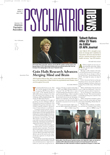Despite widespread clinical evidence of the effectiveness of electroconvulsive therapy (ECT), the view persists that cognitive side effects such as amnesia indicate structural brain damage, although the literature fails to substantiate this. Now a small but rigorously designed study contradicts this view. After administering high-dosage ECT to nonhuman primates under essentially clinical conditions, a team of investigators at New York State Psychiatric Institute and Columbia University report no visible evidence of neuropathological lesions in serial sections of brain tissue.
“This is important for psychiatrists to know because if they recommend that a very depressed patient have ECT, and the patient is fearful that the procedure will cause brain damage, they can reassure them that the latest neuropathological study shows that ECT does not cause brain damage,” Andrew Dwork, M.D., the neuropathologist who examined the frozen sections of brain tissue, told Psychiatric News.
The NIMH-funded study is also the first to compare the safety of the new convulsive treatment magnetic seizure therapy (MST) with ECT, said principal investigator Sarah H. Lisanby, M.D., of the magnetic stimulation laboratory in the department of biological psychiatry at the New York State Psychiatric Institute. She is also an associate professor of psychiatry at Columbia University College of Physicians and Surgeons (see article above).
In the March American Journal of Psychiatry, the investigators noted how flaws in previous studies of ECT, such as confounding variables, invalidated the findings. To avoid such pitfalls, their study was designed to mimic clinical conditions more closely than ever before: giving the animals general anesthesia, muscle relaxants, and oxygen and then monitoring them for seizures and physiological changes.
Twelve Macaca mulatta monkeys divided into groups of three and matched for age, weight, and sex were each given ECT, MST, or a sham treatment. All staff not involved in the interventions were masked to group assignment.
Bilateral ECT was administered at 2.5 times an individual monkey's seizure threshold, approximating high doses of bilateral ECT given to patients. MST was given using a repetitive stimulator with enhanced output. Sham interventions were identical without brain stimulation.
Interventions were given four days per week for six weeks. To provide greater sensitivity to the detection of any damage, both chronic and acute effects of treatment were sought. To allow development of any chronic neuropathologic effects, there was a five-week recovery period before the last intervention. To detect any acute brain changes, animals were euthanized three days after the last intervention.
To prevent artifacts from being introduced during their handling, brains were perfused with formalin before removal.
Frozen 40-micron sections of the left hemisphere from the amygdala through the hippocampus and the brain stem were processed with a variety of stains. Dwork examined all sections, which were masked to intervention.
None of the ECT-treated monkeys showed pathological findings. Some neurological changes in one animal given MST were consistent with hypoxia but were too acute to be linked to MST or anesthesia.
The investigators said that the study group was too small for them to detect subtle, quantitative changes such as a smaller number of neurons or a larger number of microglial cells. This is a limitation of terminal primate studies. They are now counting neurons in twice the number of animals to find whether there are subtle changes in various areas of the brain after ECT.
In addition, although animal studies cannot reveal the comprehensive effects of a lifetime of treatment and illness, primates are the closest possible models for examining the direct impact of interventions on the human brain. The investigators ruled out an examiner-based rating bias resulting in negative findings.
Regardless of its limitations, “this a very reassuring study because we have been proceeding on principle that ECT did not cause any structural brain damage,” said Mark George, M.D., an associate professor of psychiatry, radiology, and neurology and director of the function imaging division in psychiatry at the Medical University of South Carolina in Charleston.
That was based on work done almost 20 years ago. Recently investigators failed to find any structural changes in the brain when they compared MRI scans taken before and after ECT, he added.
Am J Psychiatry 2004 161 576
